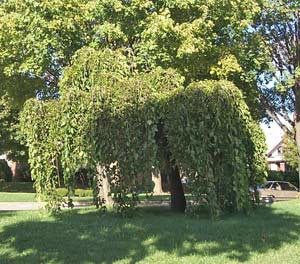Mulberry Weeping – Pruning, Winter Care and Fertilizing
 Note: The most popular Mulberry’s are the weeping types, one fruits the other does not fruit. Mulberry’s are very invasive and only the non-fruiting types should be planted. Removal of any fruiting, weeping or other types should be considered.
Note: The most popular Mulberry’s are the weeping types, one fruits the other does not fruit. Mulberry’s are very invasive and only the non-fruiting types should be planted. Removal of any fruiting, weeping or other types should be considered.
Any major pruning should be done in fall after the leaves have dropped or in early spring, before the sap starts to flow (March).The time to make a long lasting effect on the form and structure of the plant is when the tree is young. Crossing or crowded branches should be removed. Because of the weeping form, this plant will need direction and trimming to keep off the ground, and that can be done any time. If you would like the plant to be taller you can stake up a branch to give you more height. Chose a flexible branch near the top, off the main trunk and tie it to a wooden stack with cloth or flexible ties. The stake can either be put in the ground or tied two the main truck if strong enough. This is left on for two or three years until the branch has enough secondary growth to let it stand on its own. Remove any non-weeping branches as soon as you notice them, they may form below the graft.
Newly planted trees respond very well to fertilization. Either granular, liquid or stake type fertilizers can be used. Granular fertilizers can be worked into the soil around the plant at a rate of 2 lbs or 2 pints per 100 square feet of planting bed. An alternative way to apply granular fertilizers starts with drilling or punching 6” deep holes at the drip line of the tree. Poured into these holes should be a total of 2 pounds of fertilizer per 1″ of trunk diameter (divided up and poured evenly between all of the holes). These holes should not be filled with more than 1/3 of the fertilizer and then they should be top filled with soil. This method of fertilization should only be done once a year, and is best done in late fall after leaf drop, or in early spring before the buds break open. Multi Purpose 10-10-10 Fertilizer works well. Liquid fertilizers (such as Miracle Gro) are mixed with water and applied the same as you would water the plant (see product for specific details). This should be done three or four times per year starting in late April and ending in mid July. Stake type fertilizers can be used following the directions on the package. With any of the above techniques, a higher nitrogen mix should be used; 20-20-20 or similar mix. Organic fertilizers, like manure, can also be used with good results. The material should be worked into open soil at a rate of one bushel per 1″ of trunk caliper or 100 square feet of bed area. As a tree matures, less fertilizing or lower nitrogen mixes should be used.
It is important to protect young trees from the winter sun. The trunks should be wrapped with a commercial grade tree wrap for the first two or three years. This wrap can be removed in the summer and then re-applied in fall.
